January 14, 2011
Air Date: January 14, 2011
FULL SHOW
SEGMENTS
Mixed Reactions to Oil Spill Commission Report
/ Mitra Taj and Jeff YoungView the page for this story
Now that the commission charged with investigating how to avoid another BP oil spill has released its findings, all eyes are on Congress. But, as Washington Correspondent Mitra Taj reports, previous oil spill bills failed last year when the oil was still gushing in the Gulf, and passage in the new, more conservative Congress, will be difficult. Host Bruce Gellerman and Senior Correspondent Jeff Young discuss the report’s recommendations for coastal restoration and the possibility of Cuba drilling near Florida waters. (12:00)
Native Alaskans & Offshore Drilling
/ Molly LoomisView the page for this story
The Oil Spill Commission said despite pervasive problems in the oil and gas industry, efforts to move forward on offshore drilling in Arctic waters should not be prevented. But many native Alaskans fear that an oil spill the magnitude of the BP Gulf blowout, will not only damage the region’s fragile environment, but also their traditional way of life. Molly Loomis visited an Inupiat village and has our report. (08:35)
Re-Thinking Fluoride
View the page for this story
The addition of fluoride to municipal water supplies is considered one of the greatest public health accomplishments of the 20th century. But now federal agencies want to reduce the amount of fluoride in the water and ban its use as a fumigant on foods. Host Bruce Gellerman talks with Dr. Howard Koh of the U.S. Department of Health and Human Services and Chris Neurath from the Fluoride Action Network. (09:20)
Low Salt Water with Low Energy Technology
/ Lisa RaffenspergerView the page for this story
Desalination provides fresh drinking water for millions of people a day, but current technology to remove salt from seawater is extremely energy intensive. Now, a team at Yale has developed a low-energy method of desalination that could produce fresh water at half the price of existing methods, and use just one-tenth as much electricity. IEEE Spectrum and the National Science Foundation’s Lisa Raffensperger has our story. (05:15)
The View from Lazy Point
View the page for this story
In the course of a year, Carl Safina went around the world and back again. During his travels he realizes that environmental problems are inherently entwined with humanity’s past and future, and nature’s cycles of renewal. Safina is a marine science professor at Stony Brook University and heads the Blue Ocean Institute. He talks with Living on Earth’s Steve Curwood about his new book “The View From Lazy Point, A Natural Year in an Unnatural World.” (10:15)
This week's EarthEar selection
listen /
download
Allen’s Hummingbirds recorded in a Eucalyptus grove on the Santa Cruz Island off the coast of southern California.
Show Credits and Funders
Show Transcript
HOST: Bruce Gellerman,
GUESTS: Howard Koh, Chris Neurath, Carl Safina
REPORTERS: Jeff Young, Mitra Taj, Molly Loomis, Lisa Raffensperger
[THEME]
GELLERMAN: From Public Radio International - this is Living on Earth. I’m Bruce Gellerman. The President’s deepwater oil disaster commission has tough recommendations ¬ but will Congress pony up the funds? And oil companies may have to drill deep into their pockets to come up with the money to pay for damaging the Gulf of Mexico.
UHLMANN: There’s no question there’ll be criminal charges, based on the Gulf oil spill. BP will pay the largest fine ever imposed for any kind of corporate crime in U.S. history, and it’s increasingly likely that they’ll charge Halliburton as well.
GELLERMAN: Also rethinking fluoride in drinking water.
KOH: This is a very well studied public health achievement. In fact the CDC described water fluoridation as one of the top ten public health achievements of the twentieth century.
GELLERMAN: But can it be too much of a good thing? Those stories and more just ahead on Living on Earth – stick around!
[THEME: Boards Of Canada “Zoetrope” from “In A Beautiful Place Out In The Country” (Warp Records 2000)]
Mixed Reactions to Oil Spill Commission Report
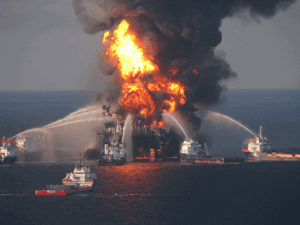
Almost nine months after the Deepwater Horizon oil rig exploded off the coast of Louisiana, Congress has yet to pass legislation to reform industry regulations. (The Coast Guard)
GELELRMAN: From the Jennifer and Ted Stanley Studios in Somerville Massachusetts, it’s Living on Earth. I’m Bruce Gellerman. Big Oil needs Big Changes, or else expect more big problems like the BP disaster in the Gulf of Mexico. That’s the warning from the presidential commission on the Deepwater Horizon oil spill.
The commission just released its novel-length final report finding systemic safety failures by the oil drilling companies in the industry and lax oversight by federal agencies made the country’s biggest oil spill almost inevitable. Former Florida Governor and U.S. Senator Bob Graham was the commission’s co-chair.
GRAHAM: If dramatic steps are not taken, I’m afraid that at some point in the coming years another failure will occur and we will wonder why did the Congress, why did the administration, why did the industry, why did the American people allow this to occur again.
GELLERMAN: To prevent another disaster, the commission has some specific and potentially costly recommendations. Living on Earth’s Jeff Young has been looking into them, and, Jeff, what are some of the highlights?
YOUNG: One big one here is the commissioners want the oil industry to create and pay for its own safety institute. Now this is similar to what the nuclear industry did after the Three Mile Island accident.
The report says the federal government needs even more changes in oversight, even though the Interior Department already did away with the old office that had rubberstamped the BP drilling requests - the Minerals Management Service.
GELLERMAN: Oh yeah, the MMS. That was the agency that they did away with after officials were found to be literally in bed with the industry.
YOUNG: Right.
GELLERMAN: So it’s gone. Did the commission think that change wasn’t enough?
YOUNG: The commissioners feel that the system that replaced MMS still lacks sufficient independence. And the report calls for a completely new body inside the Interior Department to oversee safety and evaluate new drilling permits.
And it says the person in charge should be appointed to a term, kind of like the federal reserve chairman is, that would be to insulate safety decisions from political influence. The report also calls for more money for inspectors and a permitting process that really looks into the risks of drilling in a specific area. And commission co-chair Graham says that would take a lot more input from science.
GRAHAM: Our investigation has also demonstrated that science has not been given a sufficient seat at the table. Actually, I think that is a considerable understatement. It has been virtually shut out.
GELLERMAN: Jeff, I know you have been investigating what these changes might mean on ground for the Gulf coast and I want to talk to you about that, but first let’s get some reaction to the commissions recommendations from Capitol Hill. The Obama administration could put some of these proposals in place on its own, however, the major ones will need action by Congress. But as Living On Earth’s Washington correspondent Mitra Taj tells it, that could be tough.
TAJ: Many of the recommendations of the President’s oil spill commission are nothing new on Capitol Hill. Congressman Ed Markey of Massachusetts pushed similar reforms through the House last year in the wake of the BP oil disaster. The legislation never got anywhere in the Senate, but now, presidential report in hand, Markey says he’s going to give it another shot.
MARKEY: There were many people who argued that the legislation we passed last July happened too quickly, without a comprehensive study. Well, now the comprehensive study has been completed, and I think we have a responsibility to put on the books historic legislation so that the regulations are there that guarantee to the American people that it never happens again.
TAJ: But in this new, more fiscally conservative Congress, one of the biggest challenges will be finding enough votes to secure money to pay for some of the reforms like making sure offshore oil rigs are thoroughly inspected by trained workers. Marilyn Heimen of the Pew Environment Group.
HEIMAN: Right now there’s one inspector for every 54 rigs in the Gulf of Mexico. That’s just not enough. And so, if Congress doesn’t fund those things then we are still in the same place as we were with the Gulf spill.
TAJ: But Democrats, like Markey no longer hold the majority in the House. And a Democrat no longer holds the gavel of the Natural Resources Committee - the powerful body that has jurisdiction over offshore oil production. That chairmanship now belongs to Doc Hastings, a Republican from Washington State whose top campaign contributor in the last election was the oil and gas industry. Hastings doesn’t want to slow down drilling, but he says some kind of reform is needed.
HASTINGS: Oh, I don’t think there’s any question about that because, I think the American people would want a response, so we’ll proceed in that manner.

Congressman Doc Hastings, Chairman of the House Resources Committee. (Photo: Energy Tomorrow)
TAJ: Hastings says he’s open to some of the Commission’s suggestions like creating a new agency to oversee safety in offshore businesses. He says he’ll even consider boosting the budget of the Department of Interior to strengthen its regulatory capacity.
HASTINGS: The question is where does the money come from, and I would suggest that that money should come from the existing revenue stream that comes from offshore drilling. You know, those are the things that we will look at.
TAJ: The president of the lobbying group the American Petroleum Institute, Jack Gerard, says don’t look to oil and gas companies for new money. He says more taxes are a bad idea, and removing existing tax breaks for the industry could drive business to other countries.
GERARD: The public, the voting public, made very clear in November - they want their policy members focused on economic recovery and job creation. Any decisions done unilaterally by an executive branch or done by a Congress that destroys jobs and discourages economic recovery I don’t think will be well received by the public.
TAJ: That’s an argument his lobbyist will be making to members of Congress as House and Senate committees gear up to discuss the commissions recommendations in hearings later this month.
GELLERMAN: That’s Living on Earth’s Mitra Taj on Capitol Hill. Back now to LOE’s Jeff Young for more on the presidential commission’s recommendations. So Jeff, the Gulf Coast and especially Louisiana were most affected by the disaster. You spent a lot of time there reporting during the spill from that area, and you’ve been working the phones this week - what are you hearing from your sources now?
YOUNG: The reaction is two-fold, really. There’s a lot of concern about the effects on the oil industry, which is very important to the local economy. If this new permitting process they’re talking about turns out to be very time consuming or very costly, what does that mean for drilling decisions? What does that mean for the jobs that depend on those drilling decisions?
There’s also, though, a lot of what I would call cautious optimism about these recommendations. It’s possible that this could not only make future drilling safer but could also address a chronic problem associated with drilling, and that’s the erosion of the wetlands in southern Louisiana.
GELLERMAN: What’s the oil industry have to do with erosion? And what does this report have to say about its responsibilities?
YOUNG: The report has a very thorough chapter on the need to go beyond just trying to clean up spilled oil and really get serious about restoring the coastal ecosystem. That way, you could make it more resilient so the marsh and all the life that depends on it can bounce back from this insult. Now, as many of our listeners probably know the land has basically been melting away into the Gulf for decades.
That’s partly due to the way the Mississippi River has been walled off from the wetlands, blocking the river sediment that would replenish the land. But Aaron Viles with the Gulf Restoration Network, a conservation group in New Orleans, points out that the oil industry shares a lot of the blame.
VILES: We’re losing a football field of coastal wetlands every 45 minutes. 40 to 60 percent of the reason that’s occurring is because of oil industry. They have dredged 10,000 miles of pipeline canals accessing their oil and gas fields in the marsh, and that has just sliced and diced our wetlands and put them in a state of crisis.
GELLERMAN: So what’s the commission recommending about the restoration?
YOUNG: More money, basically. The commissioners say, look, the issue has been studied sufficiently, they know what needs to be done, there just hasn’t been the money to do it. Well, now there is in the form of fines BP is going to pay. The report says 80 percent of the money BP pays for Clean Water Act violations should go straight into coastal restoration projects.
But making that happen is going to require actions by Congress. The way the law is now, that money goes into a general fund, the Oil Spill Liability Trust Fund.
GELLERMAN: How much money are we talking about?
YOUNG: Billions - maybe tens of billions. The report gives us a range of five to 21 billion dollars in possible civil fines. The range is because it depends on just what BP and the other companies end up charged with. If there is a finding of gross negligence by the companies the fines get multiplied by four. And then of course if criminal charges come, well, we’re talking about a whole other pot of money.
GELLERMAN: Hmm. Now that’s something the commission didn’t directly address but it has been on a lot of people’s minds…the possibility of BP doing the perp walk. Has this report found things that federal prosecutors might find useful?
YOUNG: It has. Even though that’s beyond the scope of what the commission was asked to do, an expert I spoke with sees ample evidence in this report to support criminal charges. And, you know, that’s the other shoe everyone’s kind of been waiting to see drop ever since the Justice Department launched its criminal investigation, very publicly, last summer.
I spoke with a law professor at the University of Michigan, David Uhlmann. Professor Uhlmann worked in the Justice Department’s environmental crimes section for 17 years. And after reading this report he says he’s very confident of criminal charges and not just against BP.
UHLMANN: BP will pay the largest fine ever imposed for any kind of corporate crime in U.S. history and it’s increasingly likely they will charge Halliburton as well. Halliburton had a whole host of issues with the cement work that it did, and that cement work has been singled out for particularly harsh criticism in the presidential commission report.
YOUNG: But you know Bruce, the funny thing is after this thing came out, even with all this swirling around these companies, their stock prices more or less held steady or went up. And the price of oil shot up that day, by two dollars a barrel.
GELLERMAN: And the higher the price of oil, the more companies will want to go into deeper waters.
YOUNG: Exactly. The economics pretty much compel the industry toward riskier drilling, including deeper water. And an interesting thing the report points out is - it’s not just U.S. deep waters. The Gulf of Mexico is shared by three countries - including Mexico and Cuba - who are looking to deeper water.
GELLERMAN: Cuba?
YOUNG: Cuba. There’s been a lot of talk about this and now it’s moving from talk to action. Kirby Jones follows this very closely. He’s a consultant who works with companies who want to do business with Cuba. He says oil exploration is imminent.
JONES: Well, it’s gone beyond a possibility and appears to be a reality this year. About a dozen countries and companies have entered into agreements to jointly explore in Cuba’s waters in the Gulf and there is a rig, deepwater rig that was constructed in China and is expected to be in Cuban waters this summer.
YOUNG: And Mr. Jones says that rig could be about 60 miles from the Florida coast.
GELLERMAN: Ooh! That’s closer than the United States permits drilling in the Gulf of Mexico now.
YOUNG: It is. It’s a profound irony that Florida has fought so hard to keep drilling away from their coast, and now Cuban drilling could be even closer to their coast.
GELLERMAN: Well, sounds like these recommendations could have impacts far beyond the Gulf of Mexico, Jeff.
YOUNG: Absolutely. You know, Alaskan communities are paying very close attention to what this might mean for industry plans to drill in Arctic waters, for example.
GELLERMAN: Living On Earth’s Jeff Young. Thanks a lot Jeff.
YOUNG: You’re welcome.
Related links:
- Click here for the Oil Spill Commission's findings.
- Senator Bob Menendez of New Jersey says he'll reintroduce his bill to raise the oil spill liability limit for companies.
- Read Congressman Hasting's statement about the report.
- To learn more about Congressman Markey's previous oil spill legislation, click here.
- Republican Congressman Fred Upton, the new chair of the Energy and Commerce Committee, said he was "disappointed" in the Commission's findings.
- Click here to read a statement from White House press secretary Robert Gibbs.
- Web extra interview with Univ. of Michigan law professor David Uhlmann, who was formerly in charge of the environmental crimes section of the Dept. of Justice.
[MUSIC: Derek trucks Band “Mahjoun” from Songlines (Sony Music 2006)]
GELLERMAN: Just ahead - what native Alaskans think about drilling in their waters – keep listening to Living on Earth!
[CUTAWAY MUSIC: Either Orchestra: “Shimmy 192” from Mood Music For Time Travelers (Accurate Records 2010)]
Native Alaskans & Offshore Drilling
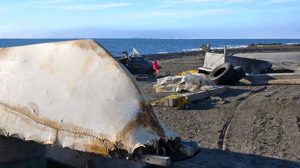
Different modes of transport — a seal skin boat, a snow machine and a sled - sit on the beach in Barrow, Alaska. White sea ice is visible in the distance. (Photo: Molly Loomis)
GELLERMAN: It’s Living on Earth, I’m Bruce Gellerman. Much of the Gulf of Mexico remains off limits to new offshore drilling, but oil companies have big plans for Arctic waters. Royal Dutch Shell hopes to become the first company to produce oil there. But, plans for a test well off the coast of Alaska’s Arctic National Wildlife Refuge have stalled after environmentalists mounted a successful legal challenge.
Oil companies say they can safely drill in the fragile arctic environment but many native Alaskans fear that an offshore spill could ruin their livelihood and damage their culture. Molly Loomis visited an Inupiat community and has our report.
OKPEAHA: These are fossilized ivory...they’re very old pieces...
LOOMIS: Richard Okpeaha sits behind a card table at the Inupiat Heritage Center in Barrow, Alaska. Bone, ivory and whalebone pieces spread before him and he proudly shows his work to a visitor. Okpeaha and his wife carve the materials into earrings and pendants for the trickle of tourists that make their way here to the northernmost city in North America.

Different modes of transport — a seal skin boat, a snow machine and a sled - sit on the beach in Barrow, Alaska. White sea ice is visible in the distance. (Photo: Molly Loomis)
OKPEAHA: The black ones are baleen whale…
TOURIST: They’re really polished…
OKPEAHA: And the white there is ivory…
LOOMIS: Okpeaha finds his carving treasures in the Beaufort Sea. Known for its extreme weather and temperatures, the Beaufort is also where Okpeaha spent countless days in his youth hunting and fishing to help feed his family and village.
OKPEAHA: We call the ocean our garden because we subsist from the ocean. If we want something from out there or something we want to eat, we go out there and look for it and find it and then bring it home. You know, it’s just like opening a refrigerator and getting something out of it and have it.
LOOMIS: But like many of his fellow Inupiat, Okpeaha worries how Barrow, which is so dependent on the health of this liquid garden, could be affected by an oil spill. Shell plans to drill in the Arctic’s Beaufort Sea have been delayed by lawsuits and government regulatory hurdles.
The company wants to build shallow wells, which it says minimizes the risks of an oil disaster like the kind that spewed hundreds of millions of gallons of oil into the Gulf of Mexico last year. Shell says the proposed wells in the Beaufort Sea would be in water just 150 feet deep compared to the deepwater wells in depths of 5-10,000 feet. The shallow wells are subject to less pressure and Shell calls the drilling process safe…but Richard Okpeaha doesn’t buy it.
OKPEAHA: It could be very hard for them if there’s a spill or accident or something. There’s ice out there. And, the ocean out there changes real quick in the current, and I completely oppose them drilling out there in the ocean.
LOOMIS: The ocean means more than just food for native Alaskans. It’s the focus of the village’s community organization, its relationships and activities.
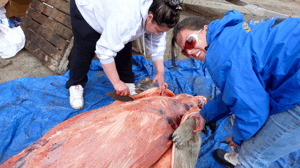
Katherine Martin (left) and Lillian Kaleak harvest the meat, blubber and skin from a bearded seal. (Photo: Molly Loomis)
[WOMEN’S VOICES. SOUNDS OF THREE WHEELERS DRIVING BY.]
[SCRAPING SOUNDS]
LOOMIS: On a grey Saturday morning, Diana Martin bustles around her front yard where a bearded seal lies belly up on a blue tarp. Martin coaches her daughter Katherine and friend Lillian on how to harvest the meat without damaging the carcass.
MARTIN: Even up to here you guys can keep the flippers….
LOOMIS: The meat will be frozen, dried and shared with elders. Nothing goes to waste, even the fat and oil will be used for cooking and the skin will be used to make a hunting boat.
[SHARPENING SOUNDS]
LOOMIS: Jesslie Kaleak Jr., the hunter that caught the seal, sharpens an ulu—a traditional knife shaped like a scallop. Kaleak explains how they will use the animal.

Jesslie Kaleak Jr. has followed in the footsteps of his father as a whaling captain. Barrow, Alaska. (Photo: Molly Loomis)
KALEAK: What we do is we go out on the ocean and we hunt for these so we can have our skin boats for spring whaling and so we can have the meat for the winter too. But, we use these traditional skin boats because they’re much quieter when we’re trying to hunt the bowhead whale.
LOOMIS: Kaleak is a second-generation whaling captain. He fears that an accident on future offshore rigs like Shell’s, could affect much more than just his livelihood.
KALEAK: We’ll pretty much lose our food, our way of life that we’ve been doing for many years; our ancestors passed on for us to hunt. These bearded seals, bowhead whales, all the animals that live in the ocean. Our food our elders taught us to hunt these so we don’t starve in this cold environment up here.
LOOMIS: Kaleak isn’t being dramatic when he says, “starve.” Food is incredibly expensive with staples like milk costing more than eight dollars a quart. Many villages are only accessed by bush plane or boat and Arctic weather can cause supply delays that leave store shelves barren.
Despite the obvious drawbacks and dangers that an oil spill could pose, not every one objects to the idea of offshore drilling. While the Inupiat Community of the Arctic Slope, which represents eight native villages, is against it, the native village of Wainwright and the Arctic Slope Regional Corporation, which is in charge of the area’s business interests, back it. It’s a contentious subject that divides communities and even families like the Kaleaks. Jesslie’s wife Lillian laughs nervously before admitting she’s a supporter.
LILIAN KALEAK: I’m not against it because I feel like homeland oil would benefit the whole country and I think that as long as they’re educated about all aspects of oil drilling, why not.
LOOMIS: Advocates focus on the benefits of energy independence and the jobs that drilling would bring local communities. Shell currently employs over one hundred Inupiat in jobs related to offshore energy development. And a study by the University of Alaska Anchorage estimates that new development could create up to 35,000 jobs statewide over the course of four to five decades.
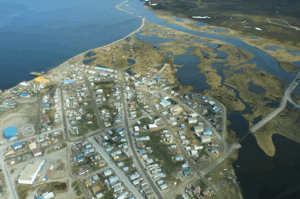
A view from the air of Kotzebue where Alex Whiting works as the village’s Environmental Specialist. (Photo: Molly Loomis)
But while job creation is one of the main reasons some native Alaskans support offshore drilling, Alex Whiting, an environmental specialist for the Village of Kotzebue, believes their logic is misguided.
WHITING: For a lot of people I guess at the end of the day they probably won’t see any economic benefit out of it, or very little. Yet everyday they’ll take a risk with the food out there that available and accessible to us all out there. Some people derive benefit while the entire population takes the risk and of course that’s what played out in the Gulf of Mexico.
LOOMIS: Whiting says even though there is a small risk of catastrophic event, he believes the risks far outweigh the benefits.
[SOUNDS OF CROWD NOISE, MEN CHEERING, WIND NOISE OF BLANKET TOSS]
LOOMIS: At an Inupiat whaling festival in Barrow, a circle of men flap a large seal skin blanket up and down, tossing boys dressed in traditional hooded jackets and blue jeans, high into the air.
[CROWD: ONE, TWO, THREE HEAVE! (LAUGHTER, CHEERING.)]
LOOMIS: Jaime Lowery stands on the sidelines, bundled against the cold night air in a long coat with a white ruff of wolf fur, and celebrates with her neighbors.
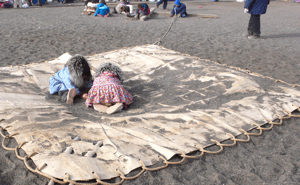
Two children play on a seal-skin blanket waiting for the blanket toss to begin. Barrow, Alaska. (Photo: Molly Loomis)
LOWERY: This festival is Inuputak - it’s a blanket toss. It’s here for our community and the different whaling crews to celebrate together. It’s just family, it’s love, it’s tradition, it’s great.
LOOMIS: Lowery is among Inupiats who have benefited from offshore drilling in the Arctic. Last year she began working as a marine mammal observer for the Arctic Slope Regional Corporation, monitoring the health of animal populations like bowhead whales. But Lowery calls the job bittersweet. She enjoys doing work to protect animals but it wasn’t until the end of the training that she learned how the information she and her co-workers collect will be used to help Shell proceed with drilling.

Jaime Lowery describes her job as a marine mammal observer as “bittersweet.” Barrow, Alaska. She wears a traditional coat made from locally harvested fur. (Photo: Molly Loomis)
LOWERY: It’s pretty controversial and contradicting to what we believe in here in the Arctic. This is our life style. This is our subsistence. It isn’t recreational.

A boy tosses candy to the crowd after being thrown high into the air at a whaling festival blanket toss. Barrow, Alaska. (Photo: Molly Loomis)
LOOMIS: Shell has already spent over 80 million dollars on offshore oil leases in the Beaufort Sea and is determined to continue moving forward to get permission to drill. Many Inupiat and other Alaskans are resigned to the notion that it’s not a question of if offshore drilling will occur, but when. They hope that the lessons learned in the Gulf of Mexico will not be forgotten as the Federal Bureau of Ocean and Energy Management reviews Shell’s application. For Living on Earth, I’m Molly Loomis in Barrow, Alaska.
[MUSIC: Offshore Drilling: David Byrne/Brian ENo “The Lighthouse” from Everything That Happens Will Happen Today (Todo Mundo 2008)]
Re-Thinking Fluoride

Chris Neurath from Fluoride Action Network pouring a glass of spring water at his home. (Photo: Bruce Gellerman)
GELLERMAN: 66 years ago this month Grand Rapids Michigan became the first city in the world to add fluoride to its drinking water. Soon, studies confirmed what researchers expected to find. The rate of dental decay in the teeth of kids born after fluoride was added to the water supply - dropped significantly. And toothpaste manufacturers quickly added fluoride to their products:
[SFX AD: KID: TIME FOR BED! YOU CAN BRUSH WITH COLGATE WINTERFRESH GEL. WOMAN: I LOVE THAT MINTY TASTE! KID: ME TOO! AND COLGATE HELPS FIGHT CAVITIES WITH THIS! WOMAN: YOU MEAN MFP FLOURIDE? KID: YEAH THAT. WOMAN: THE MAXIMUM FLORIDE PROTECTION A TOOTHPASTE CAN GIVE. KID: AND IT TASTES GREAT! ANNOUNCER: COLGATE REGULAR AND WINTERFRESH GEL. TWO GREAT TASTES, MAXIMUM FLOURIDE PROTECTION!]
GELLERMAN: Today, nearly all toothpastes contain fluoride in high concentrations. And it’s added in small doses to two-thirds of public water systems in the United States. But now, the federal government is taking two unprecedented steps to reduce the amount of fluoride you consume. The first: the U.S. Dept of Health and Human Services wants municipalities to cut the amount of fluoride in their water systems by more than 40 percent. Dr. Howard Koh is Assistant Secretary for Health at H.H.S…
KOH: Cavities have dropped by 30 to 50 percent, oral health has improved, kids go through less pain and suffering from requiring teeth to be removed. This is a very well studied public health achievement, in fact, the CDC described water fluoridation as one of the top ten public health achievements of the 20th century.
GELLERMAN: So why does the Department want to reduce the amount of fluoride that municipalities are putting into their water?
KOH: It used to be that Americans received fluoride from a single source - drinking water - but currently we are now seeing that people can receive fluoride from several other sources such as toothpaste and mouth rinses in addition to drinking water.
GELLERMAN: Well, what’s the problem, if any, of putting fluoride into the water? Why would you want to reduce the amount?
KOH: There are some unwanted health affects. Something called dental fluorosis, which is manifested by some changes in the external appearance of the teeth. These are generally very mild, barely noticeable by health professionals and dental professionals.
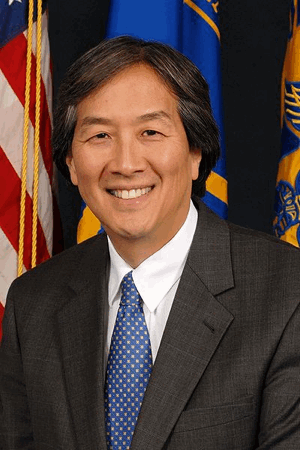
Dr. Howard Koh is Assistant Secretary for Health at the U.S. Dept. of Health and Human Services.
GELLERMAN: My understanding is that a large segment, a large percentage of the population, especially kids who are exposed to fluoride, get this enamel fluorosis, or dental fluorosis. It’s something like 40 percent, and it can be serious.
KOH: Well in the vast majority of cases, these barely noticeable markings on the outside surfaces of the teeth - doesn’t affect tooth functioning, doesn’t affect taking in foods for nutritional purposes. So, we believe the best way to proceed to maximize public health benefits is to make this adjustment and that will improve benefits for the future and reduce fluorosis as well.
GELLERMAN: What other adverse health affects are there, if any?
KOH: There are no definite links between fluoride and any systemic illnesses. There is a condition called skeletal fluorosis, but again, the EPA sets its maximum allowable concentration levels to make sure that skeletal fluorosis does not occur. So, a major area that we are focusing on is very mild dental fluorosis that we hope to reduce with this new announcement.
GELLERMAN: I was looking at the National Academy of Sciences, they did a study back in 2006 and they say skeletal fluorosis is a rare disease, but they do say there’s a consensus that fluoride can weaken bones and increase the risk of fractures. They also cite, in fact, a Chinese study shows that there’s a reduction of IQ in kids, that it may have endocrine disrupting effects. And then they cite a lack of studies in many areas, including, you know, immune effects, kidney effects, gastrointestinal. That doesn’t sound like a clean bill of health to me…
KOH: Well again, all those areas have been studied very closely by major scientific groups over many, many decades, and there has been no definitive causative link between fluoride and any of those systemic illnesses. The only area is skeletal fluorosis, and that is why the EPA sets its maximum allowable concentration to make sure that skeletal fluorosis does not occur in the United States. So, when you add it all up, what we’re talking about is barely noticeable dental fluorosis that we want to reduce the risks even further with this new announcement.
GELLERMAN: Doctor Howard Koh is an assistant secretary at the U.S. Department of Health and Human Services. The U.S. EPA is also taking action on fluoride. The agency has re-evaluated the health science of fluoride and is taking steps to ban it in pesticides used to fumigate grains, coffee beans, dried fruits and nuts. Now, in the past critics of fluoride were marginalized as nuts…like General Ripper in Stanley Kubrick’s Dr. Strangelove…who claimed fluoride was part of a conspiracy to introduce a foreign substance into our precious bodily fluids:
Longstanding fears over fluoridation of drinking water were immortalized in the Stanley Kubrick classic, “Dr. Strangelove. Have you ever seen a commie drink a glass of water?”
[MOVE CLIP: DO YOU REALIZE THAT FLUORIDATION IS THE MOST MONSTROSLY CONCIEVED AND DANGEROUS COMMUNIST PLOT WE’VE EVER HAD TO FACE? DO YOU REALIZE THAT IN ADDITION TO FLUORIDATING WATER, THERE ARE STUDIES UNDERWAY TO FLOURIDATE SALT, FLOUR, FRUITJUICES, SOUP, SUGAR, MILK, ICE CREAM…ICE CREAM, MANDRAKE! CHILDREN’S ICE CREAM?!]
GELLERMAN: Actually, today, fluoride can be found in virtually all processed foods in the United States….and critics include Noble Prize winning scientists, dentists and health researchers. Chris Neurath is with the Fluoride Action Network:

Chris Neurath from Fluoride Action Network pouring a glass of spring water at his home. (Photo: Bruce Gellerman)
NEURATH: It basically, dentistry and public health, said, ‘wow, the panacea, a silver bullet against cavities.’ And it didn’t really matter whether there was ironclad evidence that it was really working or not. Once it got going it had a life of its own, and it has continued.
GELLERMAN: Does fluoride prevent cavities?
NEURATH: The evidence actually is much weaker than the government has said - their main explanation for why cavities have drastically reduced over time in the United States - that’s absolutely true. Then they go and say, well, fluoridation has been added over time, and so therefore it must have been fluoridation that did it. Well, go to almost every other country in the world, developed countries in Europe, they do not have fluoridation. And their cavity rate has declined exactly the same, or more than in the United States. So the argument that fluoridation is the reason our rates have declined over time, it can’t be supported when you look beyond the United States.
GELLERMAN: I was reading a National Academy of Science report from back in 2006, and it does not give fluoride that’s in the water a clean bill of health by any stretch of the imagination. Am I right?
NEURATH: Absolutely. That report listed dozens of health effects, several of which the committee said were reasonably likely to occur. For example, in China, there’ve been a lot of studies on fluoride and IQ, lowering the IQ, in dozens of studies now. People who defend fluoride say they’re not good enough studies, but they have not done their own studies.

Chris Neurath from Fluoride Action Network with his son. (Photo: Bruce Gellerman)
GELLERMAN: But, what’s the concern with this type of fluoride that’s used as a fumigant and insecticide?
NEURATH: The insecticide is called sulfurofluoride and the EPA has now said that their latest health risk assessment, that there is too much total fluoride exposure to children in the United States. So much that they are not going to allow this pesticide to be continued to be used.
GELLERMAN: Why is the government moving now? I mean, for so many years it didn’t. It just said… fluoride, put it in water, put it in toothpaste, use it as a fumigant, and yet, we have these two actions happening almost at the same time.
NEURATH: Well, Fluoride Action Network has been objecting to the sulfurofluoride pesticide for about ten years, and we’ve gone through the administrative procedures at EPA. We finally had enough and we have threatened legal action. Previously they had said that exposures are safe. Now that they’re admitting they’re not, we feel that their current decisions have vindicated what we’ve been saying all along.
Even if it does benefit teeth, it absolutely doesn’t have to be in the drinking water, because 95 percent of toothpaste has fluoride in it. When it’s in toothpaste you can spit it out - you never have to get it into your body where it can do the harm to your bones, potentially to your nervous system, to you teeth.
It does its positive things on the surface of the teeth, which is where it needs to happen to prevent cavities. When it’s added to the public water, it’s basically medicating people without their informed consent. FDA would never allow a drug to be added to drinking water, but that’s exactly what it is.
GELLERMAN: Chris Neurath is with the Fluoride Action Network.
[MUSIC: Baby Elephant “Turn Up My Teeth” from Turn Up My Teeth (Godforsaken Music 2007)]
GELLERMAN: Just ahead – a new way to desalinate the sea…and lessons from the oceans - stay tuned to Living on Earth.
[MUSIC: Freddie Hubbard: “Sky Dive” from CTI Master Collection (CTI Records/Sony Legacy 1971]
Low Salt Water with Low Energy Technology
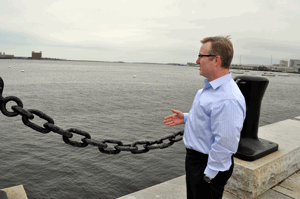
Rob McGinnis of Oasys Water hopes to market his forward osmosis desalination technology in the near future. (Photo: Lisa Raffensperger)
GELLERMAN: It’s Living on Earth, I’m Bruce Gellerman. Desalination, the process of removing salt from seawater, provides 16 billion gallons of purified water to the world every day. For some countries, including Kuwait and Saudi Arabia, desalination is already the primary source of water. There’s clearly enough ocean to satisfy the rising demand but a major limiting factor is the cost of energy for the process. Now engineers at Yale University have come up with a more efficient method of desalination, which produces fresh water at less than half the price. Lisa Raffensperger of the IEEE Spectrum, National Science Foundation program, "The Water-Energy Crunch: A Powerful Puzzle," reports.
[HARBOR SOUNDS: WATER, BOATS]
RAFFENSPERGER: As the winds pick up over Boston Harbor, engineer Rob McGinnis stands on the dock. He sweeps his arm toward the bustling waterfront.
McGINNIS: …container ships loading up not far from here, cruise ships coming in….we have the airport right next to the water, we have power plants which use the water for cooling purposes.

Rob McGinnis of Oasys Water hopes to market his forward osmosis desalination technology in the near future.
(Photo: Lisa Raffensperger)
RAFFENSPERGER: But for all the things this water is good for—
McGINNIS: It’s not good for drinking.
RAFFENSPERGER: As chief technology officer of the Oasys Water company, McGinnis will tell you that’s not strictly true. Desalination makes seawater drinkable for millions of people every day. But existing technologies consume energy—mostly fossil fuels—that could be used for other things.
Not so for the desalination technology McGinnis developed as a PhD student at Yale, in the lab of Professor Meny Elimelech. The revolutionary part of it is, says McGinnis, is the energy source.
McGINNIS: We can take this very, very low temperature energy, the kind of temperature that you would find in, say, a hot bath, so if you came into contact with it, it wouldn’t burn it you, it’s tolerable, say 40 degrees Celsius. This is the temperature at which power plants often will reject heat to the atmosphere. We can use that energy source to drive a desalination process.
RAFFENSPERGER: The process uses “forward” osmosis rather than reverse osmosis, which is the primary desalination technology today. Existing reverse osmosis requires energy to push water through a membrane, against its natural flow. Forward osmosis on the other hand doesn’t apply pressure. Seawater goes on one side of a membrane, and even saltier water goes on the other. The saltier side is called the “draw” solution, because it pulls water to that side.
But the salts in the draw solution perform a chemistry trick: when heated to low temperatures they bubble out as gases, leaving behind pure water. Professor Meny Elimelech:
ELIMELECH: So, the invention here was to come up with a draw solution that you can really separate relatively easy and inexpensive by means of waste heat.
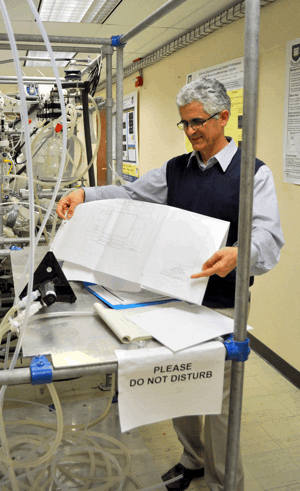
Yale Chemical Engineering Professor Meny Elimelech says if energy didn’t cost money, desalination could give the world an unlimited supply of drinking water. (Photo: Lisa Raffensperger)
RAFFENSPERGER: Waste heat, like the billows of steam you see coming from power plants. If waste heat is available, the only energy needed is for pumping. That means:
McGINNIS: That all the water we produce by this method would not require additional fuel, and this is a huge difference in terms of sustainability.
RAFFENSPERGER: The forward osmosis systems could be installed alongside power plants to use their discharged heat. Ultimately, the water produced in this way could cost half as much as water produced by reverse osmosis, and use just a tenth of the electricity.
[SOUNDS OF LAB]
RAFFENSPERGER: At Meny Elimelech’s lab at Yale, PhD student Laura Hoover is studying the membrane. Traditional membranes are too thick for forward osmosis. So she’s trying to make thinner membranes to allow more water through.
[HOOVER TURNS MACHINE ON]
HOOVER: So this is just a water bath to keep everything at the same temperature…
RAFFENSPERGER: The test unit is just two big jars of water, connected by tubes and pumps. On one side, seawater, on the other, the “draw” solution of the special ammonium carbonate salts. The water streams pass on either side of a tiny membrane.
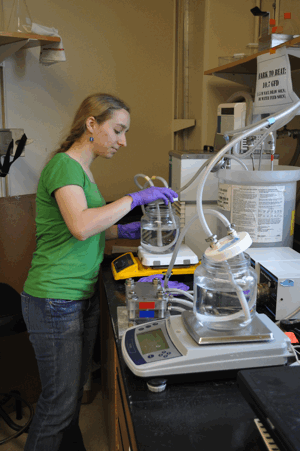
Yale PhD student Laura Hoover tests the forward osmosis technique in the lab. (Photo: Lisa Raffensperger)
HOOVER: So we have the draw solution here on mass balance so we can measure the weight that's in this container over time and so we can see how much water has moved into the draw side of the system from the feed side.
RAFFENSPERGER: We watch the numbers climb. Today’s best forward osmosis membranes can produce the same flow as the older reverse osmosis ones, and no pumping is required.
[SOUND OF WATER IN BOSTON HARBOR]
RAFFENSPERGER: Meanwhile, back in Boston, Rob McGinnis of Oasys Water is looking at the big picture. The company is close to commercializing the technology. And, there are applications besides seawater. Forward osmosis could be used to make freshwater from municipal wastewater, or from polluted water sources. But desalination is the company’s first goal. And, says McGinnis, there’s really only one question that matters.
McGINNIS: And the question is - what do we use to do that? Do we use fossil fuels or electricity that can be used for so many other things or do we find some way to use less resources to do it, and we think that's what we can do.
RAFFENSPERGER: Oasys plans to begin testing a complete desalination system soon and hopes to start selling the technology in late 2011. For Living on Earth, I’m Lisa Raffensperger in Boston.
GELLERMAN: Our story is part of the IEEE Spectrum, National Science Foundation program, "The Water-Energy Crunch: A Powerful Puzzle."
Related links:
- IEEE Spectrum’s Engineers of the New Millennium: The Water-Energy Crunch: A Power Puzzle
- Oasys Water
- Yale Professor Meny Elimelech’s biography
[MUSIC: Raffensperger: Junior Mance “I Wish I Knew (How It Felt To Be Free) from Junior Mance Special (Sackville Records 1999)]
The View from Lazy Point
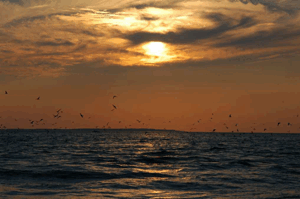
The view from the beach near Carl Safina’s house at Lazy Point on Long Island. (Photo: Carl Safina)
GELLERMAN: Carl Safina is president of the Blue Ocean Institute and a marine science professor at Stony Brook University. For most of his adult life Safina’s traveled the seven seas researching and writing. But his most recent book takes place largely in his back yard on Long Island – it’s called, “The View From Lazy Point: A Natural Year in an Unnatural Word.”
SAFINA: Well you know the east end of Long Island kind of just sticks out into the ocean, and so there are fish that come up along the coast, and they all have to round that end and Lazy Point is right near the end so that’s why it’s a great place to be stationed to see these things.
GELLERMAN: There’s an underlying theme in Carl Safina’s book, “The View from Lazy Point.” He told Living on Earth’s Steve Curwood it’s a message of hope:
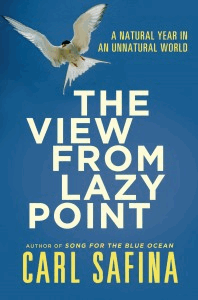
(Hentry Holt and Company)
SAFINA: Despite all the gloom and doom that we hear about the environment, I wanted to show that the world is still brimming with living vitality and there’s a lot left to save and a lot that really is worth working on.
CURWOOD: Tell me about the terns and the monarch butterflies you see at Lazy Point.
SAFINA: Terns are very long distance migrants. They go down to South America and they live an astonishingly long time. A tern that I banded in the early 80’s was recovered breeding on a nest just ten miles from Lazy Point on an island there, that tern was 27 years old, and it really floored me. And to live that long and travel that many thousands of miles and raise so many broods of young ones is a very, very impressive feat for any living thing.
And you also asked about the migrating monarch butterflies - they have a very bizarre migration. It takes them four generation to make the whole migration. I don’t know anything else like that. But, one generation starts in Mexico - they hatch, they come north, they breed in the southern United States, they hatch, go farther north, they breed around where we are, the ones that hatch where we are go into Canada, and the ones that hatch in Canada make a migration down to Mexico. It’s absolutely staggering.

The view from the beach near Carl Safina’s house at Lazy Point on Long Island. (Photo: Carl Safina)
CURWOOD: Tell me about your travels to Antarctica. You spent some time with the penguin scientists Wayne and Sue Trivelpiece, what was that like?
SAFINA: Antarctica, I think, is the most different place in the world. The ice and snow make everything seem so clean and pristine. The birds are fantastic - these big colonies of penguins - they’re stinky; they’re noisy. I was with them while they were studying the penguin’s relationship to their main food supply, which is a little shrimp - like thing called krill. And, what they were finding is that as the Southern Ocean warms up and the ice shrinks, there are fewer krill because when the krill are young they make a living by grazing algae from the underside of sea ice.
So, if the sea ice shrinks ten percent, that’s ten percent less food for the krill. And, what they were learning was that the penguins, they were getting fewer krill and that their young ones were not surviving as well. And, all of this is part of the effect of the warming of the Polar Regions. The Polar Regions are warming a lot faster than the temperate regions. And, everyone who lives or works in the Arctic or the Antarctic really feels climate changing on a year-to-year basis.
CURWOOD: In the course of your book you talk about a number of environmental problems, but you also focus on the positive. There’s a particular moment as you’re traveling, you wind up in the South Pacific, the islands of Palau there, and I’m thinking of your discussion of the parrotfish and the corals. Can you talk to us a little bit about that relationship?
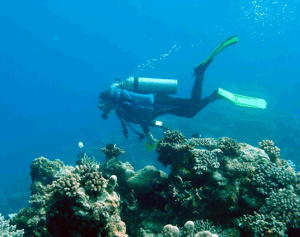
Carl Safina SCUBA diving in Palau (Photo: Carl Safina)
SAFINA: Yeah. One of the problems around the world is that coral reefs are dying. And they’re dying because of a few different things- they’re dying because it’s getting to hot for them, they’re dying because the ocean pH is getting too acidic for them - and those two things are happening because of the fossil fuels we burn and the carbon dioxide that results. They’re also dying because they’re over-fished. For quite a few millions of years, what we think of as coral reefs in the modern sense, have been possible because of a family of fish called parrotfish.
And their teeth are fused together into these scrapers. And, what they do for a living mainly, is they scrape algae that is constantly trying to grow on the corals, and, that allows the corals to grow. Palau has had a very good policy of keeping the limits on fishing within the right parameters so that the reefs still have a lot of fish. They did that mainly because they’re really famous as a tourist destination for scuba diving. But, what they got in addition to the tourists was they kept their coral reefs.
CURWOOD: Carl Safina, at one point you go out mako shark fishing by yourself. I’m wondering if you could pick up your story about what happened that day. Page 223.
SAFINA: Okay. I had the weight of the fish in the leader on one hand and the weight of the long wooden harpoon shaft overhead. A man with a spear face to face with a large dangerous animal - an old, old scene. But, when the shark presented the perfect shot, I hesitated. The shark waited. I looked deep into that black eye, undefiant, matter-of-factly, the mako informed me that at this was no game. Not a sport. That eye rolled forward just a bit, and then back to me and then inquired - what next?

Carl Safina no longer fishes for Mako sharks like this one. (Photo: Carl Safina)
I reconsidered. Then I thrust. The mako blurred into lashing froth and blood. I reached for the gaff and sank it and swept him toward me and clinched the tail rope. Now, I had my prize. Now I’d have my steaks - grills would sizzle. At the dock came the expected congratulations. The admiring onlookers, male and female, the incredulous headshakes that I had conquered this fish alone. My name found its way into the weekly fishing columns, I had distinguished myself. Perhaps people would say, ‘he’s a good fisherman.’ But with sharks declining, I could not duck the fact that I was still drawing blood from such magnificent creatures. And that made the sought-after admiration feel hollow.
CURWOOD: So, Carl Safina, your entire life you’re a fisherman, and yet it sounds like now you have stopped fishing mako.
SAFINA: That was the last one I ever killed. That’s true. And, the bluefin tuna that used to be the greatest thrill I ever had fishing, I don’t fish for them anymore either, because it’s just not fun anymore. There are very few of them - usually don’t catch anything - but when you do, it’s just sad. I still do a lot of fishing, I fish for the fish that have come back as a result of really good management, or are still abundant but I think you have to make your choices and you have to pick and choose what is quality and what isn’t.
CURWOOD: And, what does that tell us about humanity’s relationship with nature?
SAFINA: Well, I think that we still have a very ancient relationship with nature in our minds, but the world has really changed. You know, if you look at all of the big institutional frameworks by which we conduct civilization, and I mean like the economy that we have, and the religions that provide us with our values - a common thread among them is that all of them were fully developed before anyone knew that the world was round. Way before it ever occurred to anyone that people could change the world.
That is a new realization, but our institutions don’t incorporate it. That is why, for instance, the economy can say that coal is really cheap, even though the costs of coal involve putting mercury in all of our seafood, destabilizing the heat balance of the whole planet, turning the oceans more acidic and dissolving shellfish and dissolving corals. We understand only the price of things, not the costs and not the true values.
CURWOOD: Now in your book you go so far as to compare our current economic dependence on fossil fuels: oil and coal, to our economic dependence on slavery. Can you explain that to me?
SAFINA: Well, we crossed a bridge before in this country, and in fact in Western civilization, where people were saying, you know, you can’t change our energy base, or the economy will fall apart because we need cheap energy. But, the cheapest energy we’ve ever had was slaves. We were told that the economy would not survive a switch away from slaves, and we’re told now that the economy will not survive a switch away form fossil fuels. We’re using a very, very expensive and really not moral form of energy and we’re telling each other that it’s what we have to use because it’s cheap. And that’s the same argument that people who had slaves used.
CURWOOD: So, things are bad but we still have a chance to turn them right - is what you’re saying, Carl Safina.
SAFINA: Where there’s life, they’re hope. That’s a truism - and it is true. There’s a lot left. The main conclusion I came to at the end of this year of observation and of travel is that nature and human dignity require each other. Our community is not just the people around us, it’s us, it’s the living world, and it’s the generations that will come after us. We are just the current iteration in a long chain of being. We owe everything about us to the people before us. And, we have a responsibility to the people who will come after us as well.
CURWOOD: Carl Safina’s new book is called, “The View from Lazy Point: A Natural Year in an Unnatural World.” Thanks very much, Carl.
SAFINA: Thank you, very much. I really appreciate it.
GELLERMAN: Marine scientist Carl Safina spoke with Living on Earth’s Steve Curwood.
Related links:
- Carl Safina’s website
- Click here to hear a longer interview with Carl Safina
- Click here to hear Carl Safina read from his book
[HUMMINGBIRD SOUNDS]
GELLRMAN: We leave you this week all a-flutter.
[HUMMINGBIRD SOUNDS]
GELLERMAN: On Santa Cruz Island, off the coast of southern California, Allen’s Hummingbirds are doing what comes naturally: humming. These tiny jewel colored birds are aggressively territorial. The males attack and chase away much larger predatory birds including kestrels and hawks. Producer Mark Seth Lender recorded these lightweight hummers roosting in a eucalyptus grove.
[HUMMINGBIRD SOUNDS]
GELLERMAN: Living on Earth is produced by the World Media Foundation. Our crew includes Bobby Bascomb, Eileen Bolinsky, Ingrid Lobet, Helen Palmer, Jessica Ilyse Smith, Ike Sriskandarajah, Mitra Taj, and Jeff Young, with help from Sarah Calkins, and Sammy Sousa. Today we welcome our new intern, Wynn Tucker. We had engineering help this week from Dana Chisholm. Jeff Turton is our technical director. Alison Lirish Dean composed our themes. You can find us anytime at LOE dot org – and while you’re online, check out our sister program, planet harmony. Planet Harmony welcomes all and pays special attention to stories affecting communities of color. Log on and join the discussion at my planet harmony dot com. And don’t forget to check out the LOE facebook page, it’s PRI’s Living on Earth. Steve Curwood is our executive producer. I’m Bruce Gellerman -Thanks for listening!
You can hear our program anytime on our website, or get a download for your MP3 player. The address is LOE dot org. That's LOE dot O-R-G. There you’ll also find pictures and more information about our stories. And we’d like to hear from you: You can reach us at comments @ l-o-e dot org. Once again, comments @ l-o-e dot O-R-G. And you can call our listener line, at 800-218-9988. That's 800-218-99-88. And check out our Facebook page, PRI’s Living on Earth.
ANNOUNCER: Funding for Living On Earth comes from the National Science
Foundation supporting coverage of emerging science. And Stonyfield farm, organic
yogurt and smoothies. Stonyfield pays its farmers not to use artificial growth hormones
on their cows. Details at Stonyfield dot com. Support also comes from you, our listeners.
The Ford Foundation, The Town Creek Foundation, The Oak Foundation—supporting
coverage of climate change and marine issues. The Bill and Melinda Gates foundation,
dedicated to the idea that all people deserve the chance at a healthy and productive life.
Information at Gates foundation dot org. And Pax World Mutual Funds, integrating
environmental, social, and governance factors into investment analysis and decision
making. On the web at Pax world dot com. Pax World for tomorrow.
ANNOUNCER 2: PRI – Public Radio International
Living on Earth wants to hear from you!
Living on Earth
62 Calef Highway, Suite 212
Lee, NH 03861
Telephone: 617-287-4121
E-mail: comments@loe.org
Newsletter [Click here]
Donate to Living on Earth!
Living on Earth is an independent media program and relies entirely on contributions from listeners and institutions supporting public service. Please donate now to preserve an independent environmental voice.
NewsletterLiving on Earth offers a weekly delivery of the show's rundown to your mailbox. Sign up for our newsletter today!
 Sailors For The Sea: Be the change you want to sea.
Sailors For The Sea: Be the change you want to sea.
 The Grantham Foundation for the Protection of the Environment: Committed to protecting and improving the health of the global environment.
The Grantham Foundation for the Protection of the Environment: Committed to protecting and improving the health of the global environment.
 Contribute to Living on Earth and receive, as our gift to you, an archival print of one of Mark Seth Lender's extraordinary wildlife photographs. Follow the link to see Mark's current collection of photographs.
Contribute to Living on Earth and receive, as our gift to you, an archival print of one of Mark Seth Lender's extraordinary wildlife photographs. Follow the link to see Mark's current collection of photographs.
 Buy a signed copy of Mark Seth Lender's book Smeagull the Seagull & support Living on Earth
Buy a signed copy of Mark Seth Lender's book Smeagull the Seagull & support Living on Earth

